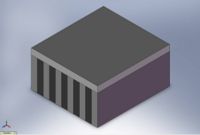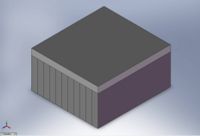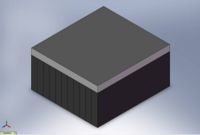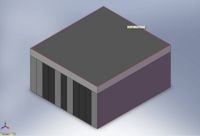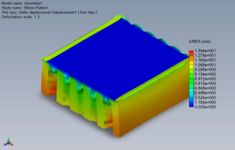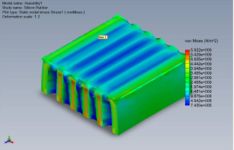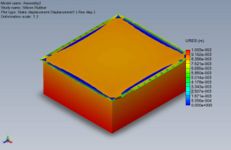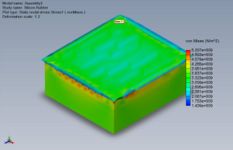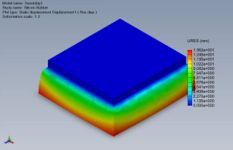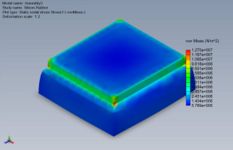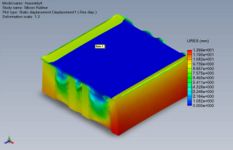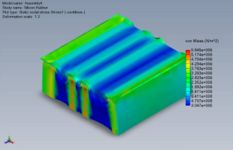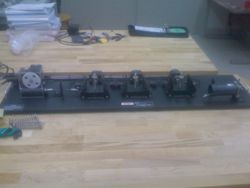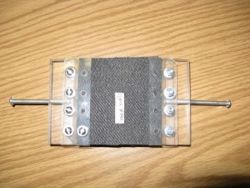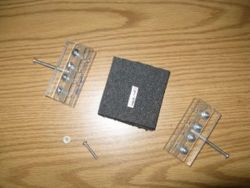Ski boot walking attachment analysis
From DDL Wiki
(→Simple Beam Model Analyses - Finite Element Analyses (FEA) of a CAD (SolidWorks) model) |
(→Simple Beam Model Analyses - Theoretical Model) |
||
| Line 31: | Line 31: | ||
*The deformation of the spring element is small enough | *The deformation of the spring element is small enough | ||
**If the vertical load compresses the rubber materials too far away from its equillibrium position, the physical springs' behaviors may diverge from that of ideal springs. | **If the vertical load compresses the rubber materials too far away from its equillibrium position, the physical springs' behaviors may diverge from that of ideal springs. | ||
| + | |||
| + | *Let the effective stiffness of each layer of rubber be 1N/mm and that of Si be 10N/mm | ||
| + | **The spring coefficients of every rubber material will be obtained using MSE lab experiment apparatus. | ||
| + | **For the time being, let the effective stiffness of the rubber be one tenth of the stiffness of Si to simplify the calculation. | ||
| + | **In the next section (FEA), SolidWorks material properties (stored in the software's library) of rubber and Si are used to simulate the model. | ||
<big>'''Conclusion'''</big> | <big>'''Conclusion'''</big> | ||
Revision as of 23:08, 10 November 2008
Contents |
Brandon
Simple Beam Model Analyses - Theoretical Model
Purpose of the Analysis
The primary goal of the simple beam model analyses using the theoretical model is to justify use of layers of various rubber materials as an effective method of adjusting the effective spring constant of specific region of the walking attachment.
Overview of Method
The theoretical model consists of several linear springs with various stiffness aligned in parallel. The theoretical model is prefere when predicting the static deformation of the walking attachment's soles. Under static load, only vertical load is applied through the layers of rubber materials, and each segment of the sole can be treated as a linear spring.
The fundamental equation defines the relationship between the displacement of linear springs in parallel and the external force being applied as follows:
keffective = [1/k1 + 1/k2]-1
The theoretical model is more reliable when no tangential force is present. This is because the Finite Element Analyses (FEA) requires adequate mesh size in order to obtain accurate results, and often times, stress concentration around sharp edges tends to approach infinity (which does not occur in reality). The theoretical model is simple, yet accurate enough for predicting the overall effective spring coefficient of the layers of rubber material as long as only vertical load is applied, and the deformation is reasonablly small. If friction force between the ground and the bottom of the walking attchment needs to be included in the analyses, the model will not satisfy the assumption that each segment of rubber material behaves as a linear spring due to the moment created by the tangential force. Also, when the significant amount of deformation occurs, behaviors of physical springs tend to diverge from that of ideal springs.
Assumptions and Boundary Conditions
- Treat each layer of rubber material as a linear spring element
- Only vertical load is being applied to the layers of rubber materials
- As mentioned above, the theoretical model is accurate only when the rubber materials do not experience shear forces. Shear forces would cause spring elements' horizontal displacement, and rubber materials would no longer behave as linear spring elements.
- The user stands on a completely flat surface
- Each spring element experiences the same amount of vertical deformation
- This assumption is used just to simplyfy the analyses. If the deformation of the walking attachment's sole while the user walks on a slope needs to be determined in future analyses, it is likely that the FEA will be the primary method.
- The deformation of the spring element is small enough
- If the vertical load compresses the rubber materials too far away from its equillibrium position, the physical springs' behaviors may diverge from that of ideal springs.
- Let the effective stiffness of each layer of rubber be 1N/mm and that of Si be 10N/mm
- The spring coefficients of every rubber material will be obtained using MSE lab experiment apparatus.
- For the time being, let the effective stiffness of the rubber be one tenth of the stiffness of Si to simplify the calculation.
- In the next section (FEA), SolidWorks material properties (stored in the software's library) of rubber and Si are used to simulate the model.
Conclusion
Simple Beam Model Analyses - Finite Element Analyses (FEA) of a CAD (SolidWorks) model
Purpose of the Analysis
There are two primary goals of the simple beam model analyses using FEA.
(1) To justify use of layers of various rubber materials as an effective method of adjusting the effective spring constant of specific region of the walking attachment (just like the primary purpose of the theoretical model analyses).
(2) To determine the change in stress distributions as the combinations of rubber materials vary
Overview of Method
The SolidWorks model consists of a 10cm x 11cm base made of aclylic and eleven 10cm x 1cm x 5cm spring element layers made of various materials. Four combinations of spring elements were simulated to undergo 1cm of uniform compression in vertical direction while the base plate was being fixed.
(1) To simulate the regions, where materials with high and low spring stiffness are altered, six layers of silicon (high stiffness material in this model) and five layers of rubber (low stiffness material in this model).
(2) To simulate the high stiffness region, a model that has silicon as all eleven of its spring elements was tested.
(3) To simulate the low stiffness region, a model that has rubber as all eleven of its spring elements was tested.
(4) To simulate the effect of varying the thickness of silicon layers and rubber layers, a model with Si-Si-Ru-Ru-Si-Ru-Si-Ru-Ru-Ru-Si combination was tested.
Each model experiences uniform 1cm vertical compression while the base plate is "fixed." Both the displacement (deformation) and stress distributions plots are obtained from each simulation, and the net reaction forces in the vertical reaction (which is the force needed to cause the simulated deformation of spring elements) are also calculated.
Assumptions and Boundary Conditions
- Treat silicon layer as a high stiffness and rubber layer as a low stiffness spring element
- Only two types of spring elements are used to simplify the analyses and focus on the effects of layer combinations and layer thickness on the effective stiffness of the entire model.
- Only vertical load is being applied to the layers of rubber materials
- The primary goal of this analsis is "to justify the use of layers of various materials as an effective method for adjusting the effective spring stiffness."
- Each spring element experiences the same amount of vertical deformation (1cm)
- If the load gets uniformly distributed over the bottom surface of the walking attachment, rubber layers (low stiffness spring elements) would deform more than silicon layers (high stiffness spring elements) do. In reality, however, the vertical force is applied on the spring elements via contact with the ground. Therefore, the deformation of the bottom surface (rather than the distribution of the load) needs to be uniform.
Conclusion
Determination of Spring Constants and Damping Coefficients
Purpose of the Analysis
We are doing this analysis to obtain at least ballpark figures for the spring constant and damping coefficient of each of the materials we will be using to construct the body of our walking attachment. These are important because they allow us to actually have numbers instead of vague ideas about how well the materials act as springs and dampers. In addition, Taka and Brandon need some kind of ballpark values in order to make their analyses more accurate and more useful.
Overview of Method
In order to obtain values for the spring constant and damping coefficient of each material, we will use the rectilinear experimental setup used in the Mechanical Systems Experimentation lab. This setup, as pictured in the first thumbnail on the right, consists of carts attached to tracks with encoders used to measure displacement. We can attach the carts to a stationary post using springs, or, in this case, our materials. In order to find the spring constant and damping coefficient, we can manually move the carts and find the response. Using MATLAB code developed for our MSE labs, we can use the logarithmic decrement method to find the spring constants and damping coefficients.
With logarithmic decrement, the damping ratio is obtained with the following formula, where n = number of peaks used, x1 = the displacement on the first peak, xn = displacement on the nth peak, and zeta = damping ratio.
Using the damping ratio, we can obtain the natural frequency with the following formula, where T = period, omega = natural frequency, and the rest of the variables have the same definitions as above.
Using the natural frequency, we can find the spring constant using the following formula, where k = spring constant and the rest of the variables have the same definitions as above.
Using the damping ratio and spring constant, we can obtain the damping coefficient using the following formula, where b = damping coefficient, zeta = damping ratio, k = spring constant, and m = mass.
Additionally, we can check our results for the spring constants by using a ramp function input and the dividing the input force by the displacement response over the course of the run. With these two tests run together, we can get at least some idea of the spring constant, and with just the one test we can get some somewhat accurate idea of the damping coefficient.
In order to attach the materials to the rectilinear system, we had to specially design brackets to hold the materials and clamp on to the provided posts and carts. To do this, we used the system pictured in the bottom two thumbnails on the right. In the first picture, you can see the completed bracket with the material already screwed inside. The material is placed in the clamp-like area between the two pieces of acrylic. We then run screws through the acrylic, through the material, and out the other piece of acrylic to create a tight hold on the material. One piece of the acrylic is then attached to the stationary post on the rectilinear setup using the large screw sticking out of the back. The other piece of acrylic is mounted to the cart using the large screw. Since we couldn't find properly sized screws, we have implemented a couple nuts to hold the screw in the proper position.
Assumptions Made
In using the same kind of analysis we used in our MSE lab, we have assumed that the springs are linear. This may or may not be the case with the materials that we are testing. In order to correct for this, we will make sure to do each test a few times using different conditions. If the values match up pretty well, we can say that our assumption of a linear spring is valid. If the values don't match up well, our assumption is probably not valid, but it doesn't make the analysis completely pointless. Even if we can't get very exact values for the spring constant and damping coefficient, we still at least can get ballpark values, which is really what we want. Since no other tool of analysis we are using is especially accurate, we just need approximate spring constants and damping coefficients. In addition, a major purpose of this analysis is to acquire the spring constants and damping coefficients relative to each other. Whether or not the obtained values are particularly accurate is of minimal consequence.
Our assumptions also exclude the effects of friction, which there will obviously be. Again, since we are not looking for exact values for the material properties, this is of little consequence. As long as we obtain material properties on the right order of magnitude, Brandon and Taka should be able to run their analyses with a fair amount of accuracy. Since the other purpose of this analysis is to help us decide how to layer the sheets of rubber and foam, we only need relative values for.
Conclusion
Because we couldn't actually perform the analysis due to Professor Ozdoganlar needing permission from the department, we can't conclude a lot from this analysis. We plan to perform the tests as soon as we get permission, and we think that they will really help us to bring our design out of the purely theoretical realm. We apologize that this couldn't be completed on time, but it happened because Professor Ozdoganlar was not here last week and we needed his approval. Essentially, we plan to get reasonably accurate values for the spring constants and damping coefficients of each material so we can then use them to help with the beam modeling and MATLAB coding analyses.
